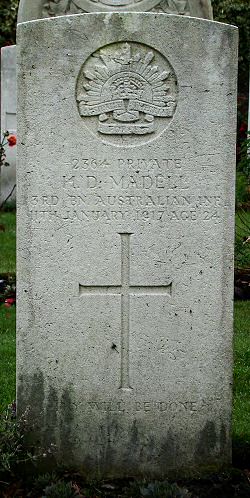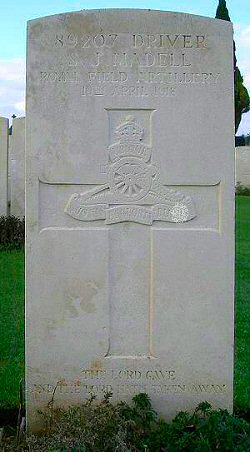|
|
The Channel Islands and the Great War
|
|
The Madells
of Mount Durand
|
| The Madell family suffered even
more than most Guernsey families as a result of the Great
War. The 1901 census shows Wallace Madell, aged 58, a lamplighter
and his wife Amelia, aged 42, living in Lower Le Marchant
Street in St Peter Port. Their family consisted of Wallace
Junior and Stanley, both aged 12, who were working as errand
boys, Roland aged 11, Herbert aged 8, Olive aged 7, Campbell
aged 5, Havelock aged 3 and Lily aged 3 months.
By 1911 the family was living at No 1, Mount Durand Steps,
St Peter Port, and Mr Madell was described as a gas office
assistant, Herbert was a miller, and Campbell and Havelock
were both errand boys. Lily was still living at home.
Wallace Junior was boarding at 38, Dorset Street, St Helier
in Jersey with the Le Quesne family, and working as a
jobbing gardener. Private Roland Madell was serving with
the 1st Battalion, the Dorsetshire Regiment, based at
Alma Barracks at Blackdown, near Farnborough in Hampshire.
Stanley Madell was a sawyer working in a timber works
and lived with his wife Rose and children, Louis aged
2 and Rose aged 1 month at Les Petites Fontaines in St
Peter Port.
|
|

|
On 17th June, 1914, shortly before war
broke out, Herbert Madell left the island to make a
new life for himself in the Colonies. He travelled out
from London on the SS Hawkes Bay as a farm student and
went on to work in New South Wales. 2364 Private Herbert
Doyle Madell of the Australian Infantry attested at
Liverpool, New South Wales on 12th May, 1915, and went
to France in October of that year. Medical records show
that he had suffered from dysentery within days of arriving,
and he continued to suffer from recurrences throughout
his time there.
He saw action at Gallipoli, and was then
transferred back to France where he was wounded in action
on 27th July, 1916. He was then transferred to England
suffering from paratyphoid on the hospital ship St Andrew
from Rouen on 1st September, 1916. He went into Wareham
Military hospital, a 185 bed hospital at Worgret Camp
near Wareham in Dorset. He died here of dysentery on
11th January, 1917, age 24. Pte Madell is buried at
Wareham Cemetery which contains 49 First World War burials.
|
His older brother Stanley joined
the Royal Horse and Field Artillery in 1915. He
went with the 1st Contingent of the 9th Divisional
Ammunition Column to Bordon Camp in England, and
then to France, arriving on 13th May, 1915. The
9th Divisional Ammunition Column consisted of
volunteers from the Royal Guernsey Artillery and
Engineers, and formed part of the 9th (Scottish)
Division. Their job was to move artillery ammunition
forward towards the front line and to recover
unused ammunition from positions that had been
abandoned. They also collected valuable empty
brass cartridge cases from the positions where
they had been used, all extremely dangerous jobs.
Some men were also posted to Trench Mortar Batteries,
raised in 1916.
89207 Driver Stanley John Madell,
of the Royal Field Artillery, died of wounds received
while on active service on 19th April, 1918, aged
29. At the time of his death Driver Madell is
listed as belonging to 'D' Battery, 160th Brigade,
RFA, which meant that he was probably with the
160th Trench Mortar battery.
He is buried in plot II at Aire
Communal cemetery, Pas de Calais in Northern France.
He is buried in a section of the cemetery used
for men who had been evacuated from the lines
to the 54th Casualty Clearing Station. Driver
Madell left a widow, Rose and two young children.
|
 |
|
|
|
A third brother, 33453 Lance Corporal Roland Madell of
the Essex Regiment died in Guernsey on 14th May, 1921,
and is buried in Candie Cemetery, St Peter Port, where
his grave bears a Commonwealth War Graves Commission headstone.
Roland Madell, a single man, had been a fisherman before
joining the 1st Battalion the Dorsetshire Regiment on
11th February, 1911. He served with them for more than
two years, and was posted to the 2nd Battalion and served
in India from 11th September, 1912 to 15th October, 1914.
He then went to Mesopotamia where he remained until 22nd
June 1915. Whilst serving there he was diagnosed as suffering
from heatstroke attributable to service during the war.
He then returned to India and whilst he was there spent
three weeks in hospital in Poona again with heatstroke,
and was said to have suffered "slight recurrences"
after that.
He then transferred to the Essex Regiment as 33453 Pte
Madell on 1st June, 1918. He was again hospitalised suffering
from heat stroke from 10th to 16th June, 1919. His Army
pension record shows that he served for more than eight
years in India, South Africa and Mesopotamia before being
transferred to the Reserve on 15th July, 1919. He came
back to Guernsey where he died less than two years later
at the age of 29.
|
|
11840 Private Campbell Madell served with the Royal Army
Medical Corps in France from May, 1915 to the end of the
war. 1024 Private Havelock Madell served with the Royal
Guernsey Light Infantry from its formation in 1916, when
he was only 19. He was wounded at Cambrai on 20th November,
1917, and invalided to England, five days later, on 25th
November. He then returned to the unit at its base in
France with the 10th reinforcement on 20th April, 1918,
just after the devastating losses of the Battle of the
Lys. These had meant that the Royal Guernsey Light Infantry
could no longer function as a fighting unit, so they were
then put to guarding Haig's headquarters at Montreuil
until the Armistice. Havelock Madell was invalided home
sick on 28th November, 1918.
Thus at least five of the six Madell brothers saw active
service in the Great War. Of these three died as a result
of the war, and are commemorated by the Commonwealth War
Graves Commission. A fourth was injured and hospitalised,
then later became ill whist in service. As far as can
be traced so far, a fifth brother, Private Campbell Madell,
saw service from 1915 to the end of the war but escaped
injury. No information has yet been found showing that
Wallace Madell saw active service.
These three brothers, less than 4 years apart in age,
died in different places from different causes but were
all victims of the Great War. Their family epitomises
the extent to which Guernseymen were involved on a worldwide
basis throughout the entire period of the war.
|
|
|